1969 in the Vietnam War
| 1969 in the Vietnam War | |||
|---|---|---|---|
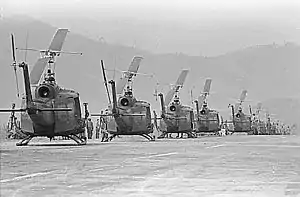 Helicopters of the 170th and the 189th Helicopter Assault Companies await the loading of troops at Polei Kleng, in the Central Highlands of South Vietnam | |||
| |||
| Belligerents | |||
|
Anti-Communist forces: |
Communist forces: | ||
| Strength | |||
|
South Vietnam 897,000 | |||
| Casualties and losses | |||
|
US: 11,616 killed South Vietnam: 21,833 killed[1]:275 | |||
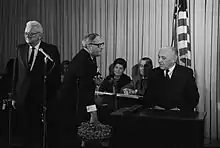
January
- 6 January
The South Vietnamese Minister of Education, Dr. Le Minh Tri, was killed when two VC on a motorcycle threw a hand grenade through the window of the car in which he was riding.
- 12 January to 7 February
In Operation Bold Mariner the 2nd Battalion, 26th Marines and 3rd Battalion, 26th Marines clear, search and depopulate the Batangan Peninsula a Viet Cong (VC) stronghold in Quảng Ngãi Province.[2]:300–3
- 18 January
The parties to the Paris Peace Talks came to an agreement on the shape of the conference tables and the placement of the representatives who were negotiating an end to the war. After being delayed for nearly six weeks over procedural disagreements raised by South Vietnamese Vice President Nguyễn Cao Kỳ, the parties came to an accord that "The two sides would be 'clearly separated' by two rectangular tables with a round one in the middle" and that the tables would have "no nameplates, no flags and no written minutes of the understanding" on the setup.
- 20 January
Richard Nixon is inaugurated as 37th President of the United States.
- 21 January
The White House issues National Security Study Memorandum 1 to the U.S. Ambassador in Saigon, the Joint Chiefs of Staff and Military Assistance Command Vietnam (MACV) "to develop an agreed evaluation of the situation in Vietnam as a basis for making policy decisions."[3]
- 22 January to 18 March
The U.S. 3rd Marine Division launched Operation Dewey Canyon to attack People's Army of Vietnam (PAVN) base areas in the A Shau and Song Đa Krông Valleys of Quảng Trị Province. The operation results in 1,617 PAVN killed while 130 Marines were killed.[2]:50
February
- 17 February to 31 October
U.S. Army and Army of the Republic of Vietnam (ARVN) forces begin the multi-division Operation Toan Thang III to keep pressure on PAVN/VC forces in III Corps. The operation results in 41,803 PAVN/VC killed and 3,299 captured, U.S. losses were 1,533 killed.[4]:A-17
- 22 February

The PAVN launches the Tet 1969 offensive against U.S. military targets near Saigon and Da Nang. The attacks were quickly beaten off. In the attack on Bien Hoa Air Base the PAVN lost 264 killed and 87 captured while ARVN losses were 10 killed and U.S. losses were one killed. Around Da Nang the PAVN/VC lost over 500 killed.[2]:101
The PAVN attacked Tiên Phước Camp which was defended by the 5th Special Forces Detachment A-102 and Civilian Irregular Defense Group program (CIDG) forces. The base was secured the following morning for a loss of 1 U.S. and 54 CIDG killed.[5]
- 23 February
A PAVN rocket attack on Da Nang Air Base destroyed a 450,000 gallon fuel tank beside the base and damaged a Marine A-6 Intruder.[2]:97
PAVN sappers attacked Hill 327 and the positions of the 2nd Battalion 7th Marines northwest of the Hill, both attacks were beaten back with 18 Marines killed and 80 wounded while the PAVN lost 75 killed or captured.[2]:100
A PAVN sapper attack on Dầu Tiếng Base Camp resulted in 21 U.S. and 73 PAVN killed.
The PAVN 271st and 272nd Regiments attacked Patrol Base Diamond I occupied by the U.S. 2nd Battalion, 27th Infantry Regiment. The attack was repulsed with artillery and gunship fire with an estimated 118 PAVN killed and two captured.[6]
- 26 February
A PAVN sapper attack on Củ Chi Base Camp destroyed nine Boeing CH-47 Chinook helicopters of the 242nd Assault Support Helicopter Company.[7]
- 28 February - 2 March
In the Fourth Battle of Nakhang the PAVN 316th Division overran Royal Lao Army (RLA) forces at Lima Site 36 at Na Khang. The PAVN lost an estimated 250 killed and the RLA lost nine killed. The PAVN lost 26 killed while an entire RLA battalion was killed.[8]:209
- 28 February to 8 May
The U.S. 101st Airborne Division and ARVN 1st Division launch Operation Massachusetts Striker to keep pressure on the PAVN in the southern A Shau Valley. The operation results in 223 PAVN killed and two captured while U.S. losses were 59 killed.[9]
- 28 February to 28 February 1971
The 11th Light Infantry Brigade launches Operation Iron Mountain to attack PAVN/VC bases and logistics routes in southeastern Quảng Ngãi Province. The operation results in 4,589 PAVN/VC killed and 137 captured while U.S. losses are 440 killed.[10]
March
- 1 March to 8 May
The 4th Marine Regiment launches Operation Purple Martin against three PAVN regiments operating near the Vietnamese Demilitarized Zone (DMZ). The operation results in 347 PAVN killed and approximately 100 Marines killed.[2]:58
- 1 March to August 1971
In the DMZ Campaign (1969-71) the 1st Brigade, 5th Infantry Division (Mechanized) assumed responsibility for the defense of the DMZ from the 3rd Marine Division as it withdrew from South Vietnam.
- 2 March
People's Liberation Army troops attacked Soviet border guards on Zhenbao Island, marking a new low in relations between North Vietnam's principal allies.[11]
- 3 March
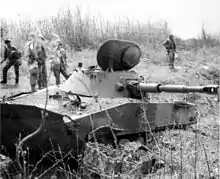
Ben Het Camp was attacked by the PAVN 66th Regiment, supported by armored vehicles of the 4th Battalion, 202nd Armored Regiment. Two PT-76s and one BTR-50 were destroyed by U.S. M-48s of the 1st Battalion, 69th Armor Regiment in one of the few armored battles of the war.[12][13]:150–2
- 3-4 March
Company A, 3rd Battalion, 8th Infantry loses 21 killed fighting a PAVN battalion at Landing Zone Brace in the Plei Trap Valley approximately 44 km west of Kontum.[14]
- 5 March
South Vietnamese Prime Minister, Tran Van Huong, narrowly escaped assassination by a four man VC team as he was being driven to his home in Saigon. Huong's car was attacked by the VC who were wearing stolen uniforms of the Vietnamese Rangers however Saigon police and ARVN troops opened fire and gave the driver time to accelerate and escape.[15]
- 15 March to 2 May
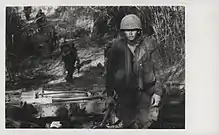
The 3rd Marine Division and a regiment from the ARVN 1st Division launch Operation Maine Crag in the "Vietnam Salient" of Quảng Trị Province. The operation uncovered large amounts of supplies and resulted in 207 PAVN killed.[2]:67
- 17 to 24 March
The 11th Armored Cavalry Regiment conducted Operation Atlas Wedge in the Michelin Rubber Plantation, resulting in 335 PAVN killed and 11 captured for the loss of seven U.S. killed.[16]
- 17 March - 7 April
Operation Raindance was a USAF interdiction bombing campaign to support RLA forces fighting the PAVN/Pathet Lao on the Plain of Jars.[8]:207–13
- 18 March to 28 May 1970
Operation Menu was the codename of a covert United States Air Force (USAF) Strategic Air Command (SAC) bombing campaign conducted in eastern Cambodia from 18 March 1969 until 26 May 1970. The supposed targets of these attacks were PAVN/VC sanctuaries and base areas used for resupply, training, and resting between campaigns across the border in the South Vietnam.
- 18 March to 28 February 1971
The 196th Light Infantry Brigade and ARVN 5th Regiment, 2nd Division launch Operation Frederick Hill to pacify the coastal areas of Quảng Tín Province. The operation results in 7,514 PAVN/VC killed and 133 captured, U.S. losses are 572 killed.[17]
- 18 March to 28 February 1971
The 198th Light Infantry Brigade and ARVN 6th Regiment, 2nd Division launch Operation Geneva Park to pacify Quảng Ngãi Province. the operation results in 2,337 PAVN killed and 67 captured, U.S. losses are 231 killed.[18]
- 23 March to 3 April
The 3rd Battalion, 9th Marines and elements of the 1st Brigade, 5th Infantry Division launch Operation Montana Mauler against the PAVN 27th Regiment north of Firebase Fuller in Quảng Trị Province. The operation results in 271 PAVN killed, U.S. losses are 38 killed.[2]:60
- 24 March
The VC attacked Tam Soc Base in Sóc Trăng Province killing two U.S. advisers from MACV Advisory team 71 and capturing another two, both of whom died in captivity.
- 25 March
John Lennon and Yoko Ono begin their first Bed-In for Peace at the Hilton Amsterdam.[19]
- 31 March to 29 May
.jpg.webp)
The 1st Marine Division and ARVN 51st Regiment, 1st Division launch Operation Oklahoma Hills in southwest Quảng Nam Province. the operation results in 589 PAVN killed, U.S. losses are 43 killed.[2]:116
April
The number of American military personnel in Vietnam peaked at 543,000.[20] Tensions and casualties start escalating months after the Vietnam War begins both in Vietnam and back home in the United States. [21][22]
- 3 April
The U.S. Department of Defense announced that the death toll for American soldiers in the war had exceeded the 32,629 who had died in the Korean War, based on 312 additional deaths during the week from March 22 to March 28 to bring the toll to 33,641.[23]
- 14 April
A PAVN/VC attack on Patrol Base Diamond III was repulsed with 198 PAVN/VC killed and eight captured and 40 individual and 42 crew-served weapons captured; U.S. losses were 13 killed.[24][25]
- 15 April to 1 January 1971
The 173rd Airborne Brigade, ARVN 2nd Division and 22nd Division and Regional Force and Popular Forces launch Operation Washington Green a security and pacification operation in Bình Định Province. The operation results in 1,957 PAVN/VC killed, U.S. losses are 227 killed.[26]
- 20 April
President Nixon announced that he would order the withdrawal of 150,000 U.S. troops from South Vietnam over the next 12 months in a gradual policy of Vietnamization, putting more responsibility on the South Vietnamese.[27]
- 21 April
In one of the first Fragging incidents of the war, a grenade was thrown into the office of K Company, 9th Marine Regiment, at Quảng Trị Combat Base, killing First Lieutenant Robert T. Rohweller. Private Reginald F. Smith pleaded guilty to the premeditated murder and was sentenced to 40 years' imprisonment; he died in custody on 25 June 1982.[28][29]
- 25 April
Elements of the PAVN 271st Regiment attacked Patrol Base Frontier City southeast of Tây Ninh. The attack was countered with intensive fire from fixed wing and helicopter gunships and the PAVN lost 214 killed and six captured for no U.S. losses.[30]
- 27 April
A grass fire spread to the Marines/Navy ammunition supply point 1 near Hill 327 causing a massive explosion and fire.[2]:355
May
- 2 May to 16 July
The 3rd Marine Regiment launches Operation Virginia Ridge to engage the PAVN 27th and 36th Regiments near the central DMZ. The operation results in 560 PAVN killed and 17 captured, Marine losses were 16 killed.[2]:75
- 6 May
A CH-47 carrying 83 persons crashed 3 miles (4.8 km) southwest of Phước Vĩnh Base Camp, killing 40 of those on board.[31]
- 10 May to 7 June

The U.S. 101st Airborne Division and ARVN 1st Division launch Operation Apache Snow in the A Shau Valley. The operation results in 977 PAVN killed and five captured while U.S. losses were 113 killed and ARVN losses were 31 killed.[32] Most of the U.S. casualties were in the Battle of Hamburger Hill from May 13-20 where U.S. forces attacked heavily fortified PAVN positions on Hill 937. 630 PAVN, 72 U.S. and 31 ARVN were killed in the fighting for Hill 937.[33]
- 11 May
An estimated 600 PAVN troops attacked Landing Zone Oasis resulting in 11 U.S. killed and three captured and over 100 PAVN killed.
- 12-15 May
The PAVN V-16 Sapper Battalion attacked Landing Zone Professional occupied by elements of the 1st Battalion, 46th Infantry Regiment and 1st Battalion, 14th Artillery. The attack was repulsed but the PAVN continued to mortar the base and set up heavy machine guns to prevent helicopter resupply, shooting down a CH-47B on 15 May.
- 13 May
The PAVN 6th Regiment and K-12 Sapper Battalion attacked the 2nd Battalion, 501st Infantry Regiment, 2nd Battalion, 11th Artillery and 2nd Battalion, 319th Artillery on Firebase Airborne killing 22 U.S. for the loss of 40 PAVN killed.[34]
Units of the PAVN 7th Infantry Division attacked Firebase Gela, the assault was repulsed for the loss of three U.S. and an estimated 39 PAVN soldiers killed.[35]
- 15 May to 14 August
The 1st Brigade, 101st Airborne Division launches Operation Lamar Plain in Quảng Tín Province. The operation results in 524 PAVN/VC killed and 21 captured and U.S. losses were 116 killed and one missing.[36]
- 18 May
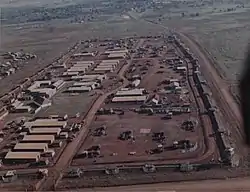
Elements of the VC 5th Division attacked Xuân Lộc Base Camp which was defended by the 7th Battalion, 9th Artillery Regiment and the 2nd Battalion, 35th Artillery Regiment, 54th Artillery Group. The VC penetrated the perimeter but were eventually driven out airstrikes and a unit of the 11th Armored Cavalry Regiment. The attack resulted in 24 VC and 14 U.S. killed.[37]
- 26 May to 7 November
The 1st Marine Division, ARVN 51st Regiment and Republic of Korea Marine Corps 2nd Marine Brigade launch Operation Pipestone Canyon to pacify and clear Go Noi Island, Quảng Nam Province. The operation results in 852 PAVN/VC killed and 58 captured, U.S. Marine losses were 71 killed.[2]:187
June
- 1 June
During their second Bed-in for Peace at the Queen Elizabeth Hotel, Montreal, John Lennon, Yoko Ono and friends record Give Peace a Chance which is released as a single in July 1969.[38]
- 3 June
74 U.S. Navy crewmen aboard the USS Frank E. Evans died in a collision with the Royal Australian Navy light aircraft carrier HMAS Melbourne during an exercise in the South China Sea.[39]
- 6 June
.jpg.webp)
The Battle of Binh Ba, also known as Operation Hammer, was a hard-fought, but one-sided, battle. The action occurred on 6–8 June 1969 when troops from the 5th Battalion, Royal Australian Regiment (5RAR) fought a PAVN/VC force in the village of Binh Ba, 5 kilometres (3.1 mi) north of Nui Dat in Phuoc Tuy Province resulting in 107 PAVN/VC killed and eight captured for the loss of one Australian killed.
- 7 June
Dan Bullock was the youngest U.S. serviceman to be killed in the war at age 15. Having lied about his age to join the Marine Corps he was killed in a sapper attack at An Hoa Combat Base.[40]
- 8 June
Following a meeting at Midway Island between President Richard Nixon and South Vietnamese President Nguyễn Văn Thiệu, Nixon announced that 25,000 American troops would be withdrawn from South Vietnam by the end of September.[41]
First Lieutenant Sharon Ann Lane, an army nurse at the 312th Evacuation Hospital at Chu Lai Base Area, was killed in a PAVN rocket attack. She was the only U.S. servicewoman killed by hostile fire during the war.[42]
- 10 June
The VC announced that it had selected leaders for its "Provisional Revolutionary Government of the Republic of South Vietnam" (PRG), a "government in exile" to assume leadership if the VC and North Vietnam were successful in conquering South Vietnam.[43] Former South Vietnamese lawyer and VC president Nguyễn Hữu Thọ was named as chairman of the advisory council to the PRG, and Huỳnh Tấn Phát was named the PRG Council President.[44]
- 11 June
The PAVN 35th Sapper Battalion attacked the 3rd Battalion, 21st Infantry Regiment and 3rd Battalion, 82nd Artillery on Landing Zone East killing 16 U.S. for the loss of 27 PAVN killed.
- 12 June to 6 July
The 1st Battalion, 9th Marines, elements of the 1st Brigade, 5th Infantry Division and the ARVN 2nd Regiment launch Operation Utah Mesa against the PAVN 24th Regiment near Khe Sanh. The operation results in 309 PAVN killed and U.S. losses were 14 killed.[2]:72
- 13 June

Secretary of Defense Melvin Laird announced that the first U.S. forces to leave South Vietnam would be 900 infantrymen from the 9th Infantry Division.[45]
- 18 June to 15 August
The 101st Airborne Division launches Operation Montgomery Rendezvous in western Thừa Thiên Province to interdict PAVN infiltration routes and forestall attacks on Huế. The operation results in 393 PAVN killed and 87 U.S. killed.[46]
- 18-27 June
Campaign Toan Thang was the first PAVN wet season offensive of the Laotian Civil War. The PAVN 312th Division captured Muang Soui from the RLA.[8]:207–13
- 19 June
The PAVN 4th Regiment attacked Firebase Tomahawk occupied by the 2nd Battalion, 501st Infantry Regiment and 2nd Battalion, 138th Artillery. The assault was repulsed for the loss of 13 U.S. (including 9 National Guardsmen from the 138th Artillery) and 23 PAVN killed.[47]
- 19-21 June
The PAVN began shelling Tây Ninh Combat Base and then on 21 June launched a ground assault which was repulsed resulting in 194 PAVN and 10 U.S. killed.[48]
- 20 June - September
The Green Beret Affair began when Chu Van Thai Khac, a South Vietnamese agent suspected of being a double agent, was abducted by three Special Forces soldiers, drugged, shot and his body dumped in Nha Trang bay. On learning of the murder, eight men were arrested including 5th Special Forces Group commander, Colonel Robert B. Rheault. Army defense lawyers for the eight soldiers called General Abrams and CIA officials to the witness stand. Both declined to get involved in the proceedings and testify. Finally in September 1969, Secretary of the Army Stanley Resor announced that all charges would be dropped against the eight soldiers since the CIA, in the interests of national security, had refused to make its personnel available as witnesses, therefore making any manner of a fair trial impossible.[49]
- 21-6 June
Operation Left Jab was an RLA operation to interdict the Sihanouk Trail in southern Laos. The operation succeeded in temporarily disrupting PAVN logistics routes into Cambodia.[8]:222
- 27 June
Life magazine published the photographs of 242 Americans killed in one week in Vietnam; this is now considered a watershed event of negative public opinion toward the war.[50][51]
- 29 June to 30 August

In Operation Keystone Eagle the initial units of the 3rd Marine Division withdrew from South Vietnam.[2]:128–32
July
- 1-15 July
Operation Off Balance was an unsuccessful RLA offensive to recapture Muang Soui.[8]:201–14
- 8 July
The first of 25,000 American troops to be withdrawn from South Vietnam arrived at McChord Air Force Base at 18:30 in a C-141 transport plane.[52]
- 12 July
Royal Lao Air Force Major Lee Lue is killed by PAVN/Pathet Lao antiaircraft fire in his T-28D near Muang Soui. At the time of his death he had flown over 5,000 combat sorties.[53]
- 13 July to 15 August
The 2nd Brigade, 101st Airborne Division and ARVN 54th Regiment, 1st Division launch Operation Campbell Streamer in the Bạch Mã area near Huế. The operation results in 51 PAVN killed and one captured.[54]
- 21 July to 25 September
The 3rd Marine Division and elements of the 1st Brigade, 5th Infantry Division launch Operation Idaho Canyon in north-central Quảng Trị Province. The operation results in 563 PAVN killed.[2]:149
- 23 July to 10 March 1971
The 198th Light Infantry Brigade launches Operation Nantucket Beach on the Batangan Peninsula. The operation results in 630 PAVN/VC killed, U.S. losses are 51 killed.[55]

- 25 July
What would become known as the "Nixon Doctrine" was outlined for the first time in an informal press conference with reporters who had accompanied President Nixon to Guam during his Asian tour. In remarks later published, but given at the time "for attribution but not direct quotation", Nixon said, "I believe that the time has come when the United States, in our relations with all of our Asian friends, be quite emphatic on two points: One, that we will keep our treaty commitments... but, two, that as far as the problems of internal security are concerned, as far as the problems of military defense... that the United States is going to encourage and has a right to expect that... the responsibility for it taken by, the Asian nations themselves."[56]
- 28 July - 17 October
Operation Junction City Jr. was mounted by the RLA in an attempt to neutralize the PAVN logistics hub at Tchepone. The PAVN lost material and an estimated 500 killed but managed to withdraw most of their forces from the area.[8]:217–21
- 30 July
President Nixon made his only presidential visit to South Vietnam, meeting U.S. personnel at Dĩ An Base Camp.[57]
August
- 4 August
U.S. National Security Adviser Henry Kissinger secretly met with North Vietnam's former Foreign Minister, Xuan Thuy, to bypass the deadlocked Paris Peace Talks.[58]
- 5 August
North Vietnam released three American prisoners of war, among them was U.S. Navy seaman Douglas Hegdahl who had memorized the names of other prisoners.[59]
- 6 August - 30 September
Operation Kou Kiet was an RLA offensive with extensive U.S. air support that succeeded in capturing the Plain of Jars from PAVN/Pathet Lao forces.[8]:214–7
- 7 August
A VC sapper attack on Cam Ranh Bay penetrated the north perimeter and the sappers threw Satchel charges into the 6th Convalescent Center killing two Americans and wounding 98 and damaging 19 buildings for no VC losses.[60]
- 21 August
Operation Camden was a 1 ATF military operation in support of the 501 Land Clearing Company, United States Army Corps of Engineers who were undertaking land clearing operations in the Hat Dich Area.
- 22 August
Tran Van Huong was fired as Prime Minister by President Thiệu.[61] ARVN General Tran Thien Khiem was appointed in his place the next day to head a new government.
- 24 August
The first publicized combat refusal of American soldiers in the war took place when "A" Company of the 196th Light Infantry Brigade, 23rd Infantry Division (Americal) refused to obey the orders of their lieutenant. The battalion commander, Lieutenant Colonel Robert C. Bacon, traveled to the area the next day and reassigned the Lieutenant to another position.[62]
September
- 2 September
With the outcome of the war still in question, Hồ Chí Minh died on the morning of 2 September 1969, at his home in Hanoi at age 79 from heart failure.
- 5 September
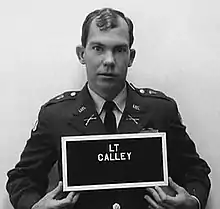
U.S. Army Lieutenant William Calley was charged with six counts of premeditated murder for the 1968 My Lai Massacre.[63]
- 14 September
A shaped charge on the perimeter of Firebase Gela accidentally discharged killing 8 U.S. soldiers.[64]
- 14 September - 25 April 1970
Campaign 139 was a PAVN combined arms rainy season offensive to recapture the Plain of Jars. The PAVN were eventually forced back with extensive air support but they had succeeded in inflicting heavy losses on the RLA.[8]:248–58
- 20 September
74 of 75 persons on an Air Vietnam Douglas DC-4 were killed after a mid-air collision with a USAF F-4 Phantom. Both aircraft were approaching Da Nang Air Base when the F-4 clipped the wing of the DC-4 causing it to crash into a field, killing two farmers on the ground.[65]
- 20 September - 9 March 1970
Operation Diamond Arrow was an RLA operation to retain control of the strategic road intersection of Routes 16 and 23 at Thatheng in southern Laos. The RLA successfully defended Thatheng and killed an estimated 500 PAVN/Pathet Lao for the loss of 40 killed and 30 missing but ultimately abandoned the position on 4 April.[8]:221–4
- 30 September to 27 November
In Operation Keystone Cardinal the remaining units of the 3rd Marine Division withdrew from South Vietnam.[2]:167–8
October
- 2 October
A U.S. Navy C-2A Greyhound crashed into the Gulf of Tonkin on a flight from Naval Air Station Cubi Point to the aircraft carrier USS Constellation killing all 27 onboard.[66]
Hanna E. Crews a Donut Dolly died of head injuries after a vehicle accident near Bien Hoa, becoming the first of three Donut Dollies to die in the war.[67]
- 8-11 October
The Weatherman faction of the Students for a Democratic Society launch the Days of Rage protests in Chicago to "bring the war home".[68]
- 10 October
On the advice of National Security Adviser Kissinger, President Nixon issued secret orders to the Joint Chiefs of Staff to commence Operation Giant Lance, the sending of bombers armed with nuclear weapons toward Moscow in an effort to convince the Soviet leaders that he was not reluctant to launch a nuclear war in an effort to end the ongoing war. A squadron of 18 B-52 bombers, each carrying nuclear bombs, would be sent out on 27 October.[69]
- 12 October
Anti-war protesters invaded a U.S. Army base for the first time, as an estimated 5,000 anti-war demonstrators crossed into the boundaries of the base at Fort Dix, New Jersey. The group was driven back by about 1,000 military policemen with tear gas, and there were no arrests and no injuries.[70]
- 15 October
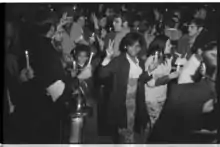
Hundreds of thousands of people took part in the Moratorium to End the War in Vietnam demonstrations across the U.S. on a regular workday. Estimates of turnouts were 250,000 in Washington DC and 100,000 in Boston.[71]
- 22 October to 18 January 1970
The 1st Brigade, 5th Infantry Division, 101st Airborne Division and ARVN 1st Division launch Operation Fulton Square in the lowlands of Quảng Trị Province. The operation results in 384 PAVN killed, U.S. losses are 28 killed.[2]:171
- 25-9 October
Tropical storms Kate and Joan cause the worst flooding in Quảng Nam Province since 1964, over 200 people, mostly civilians, drowned; over 240,000 temporarily or permanently lost their homes; and 55 percent of the season's rice crop was ruined.[2]:108–9
- 27 October - 1 November
The PAVN besiege Landing Zone Kate occupied by the 5th Special Forces Detachments A-233 and A-236 and their Montagnard forces and elements of the 5th Battalion, 22nd Artillery and 1st Battalion, 92nd Artillery. The base was abandoned on the night of 1 November and the US and Montagnard forces evacuated towards the nearby Bu Prang Camp.[72]
- October-December
The PAVN besiege Duc Lap Camp.[73]
November
- 1 November to 1 May 1970
Following the conclusion of Operation Toan Thang III, U.S. and ARVN forces begin Operation Toan Thang IV with largely the same forces and objectives. When the operation concludes on May 1 1970 14,479 PAVN/VC have been killed for the loss of 685 U.S. killed.[74]
- 3 November
President Nixon addressed the nation on television and radio at 9:30 p.m., Washington time, to announce his plans to end American involvement in the war. Nixon gave his reasons for rejecting immediately removing all troops, framing that option as the "first defeat in our Nation's history" that "would result in a collapse of confidence in American leadership, not only in Asia but throughout the world." Nixon instead reiterated his plan for Vietnamization, "the complete withdrawal of all U.S. combat ground forces and their replacement by South Vietnamese forces on an orderly scheduled timetable" but added that he did not intend to announce details of the timetable. In closing, he described the people who would support his plan for a drawdown as "the great silent majority of my fellow Americans", in contrast to a "vocal minority" of protesters which, if their will prevailed "over reason and the will of the majority", would mean that the United States would have "no future as a free society."[75][76]
- 6 November
A PAVN sapper attack on Firebase St. George occupied by the 1st Battalion, 14th Infantry and 1st Battalion, 9th Artillery resulted in nine U.S. killed.
- 13 November
The story of the 1968 My Lai Massacre was revealed to the public by freelance American investigative reporter Seymour Hersh, who was contributing to the Dispatch News Service.[77] The New York Times published a similar report at the same time.[78]
- 15 November
In Washington, D.C., more than 500,000 protesters staged "the largest peace march on Washington in American history" for the second "Moratorium to End the War in Vietnam". The event, which was also held on a smaller scale in other American cities, included a symbolic "March Against Death".[79]
December
- 1 December
The first draft lottery in the United States since 1942 (and the first in peacetime) was held, and September 14 was the first of the 366 days of the year selected, with Congressman Alexander Pirnie of New York making the first selection.[80]
- 7 December to 31 March 1970
The 2nd Brigade, 101st Airborne Division and ARVN 1st Division launch Operation Randolph Glen to engage PAVN/VC units and interdict supply lines into the lowlands of Thừa Thiên Province. The operation results in 670 PAVN killed, U.S. losses are 123 killed and four missing.[81]
- 20 December
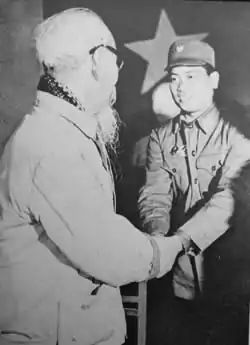
VPAF pilot Nguyễn Văn Cốc made his ninth kill becoming the highest-scoring VPAF ace of the war.[82]
- 22 December
A bomb exploded on an Air Vietnam DC-6 descending into Nha Trang. The plane crashed into a school killing 24 at the school (most of them schoolchildren) and 10 of the 70 passengers.[83]
- 26 December - 5 January 1970
The SS Badger State under contract to Military Sea Transportation Service and carrying a load of munitions bound for Da Nang had a bomb explode onboard causing a fire. The crew abandoned ship with 29 crewmen killed and the ship drifted before sinking on 5 January.[84]
Year in numbers
| Armed Force | Strength[85] | KIA | Reference | Military costs - 1968 | Military costs in 2020 US$ | Reference | |
|---|---|---|---|---|---|---|---|
| 897,000 | 21,833 | ||||||
| 549,500 (January), 474,400 (December) | 11,616 | [86] | |||||
| 48,869 | [87] | ||||||
| 11,568 | |||||||
| 7,672 | |||||||
| 189 | |||||||
| 552 | |||||||
References
| Wikimedia Commons has media related to Vietnam War in 1969. |
- Clarke, Jeffrey (1988). United States Army in Vietnam: Advice and Support: The Final Years, 1965-1973. Center of Military History, United States Army. ISBN 978-1518612619.
 This article incorporates text from this source, which is in the public domain.
This article incorporates text from this source, which is in the public domain. - Smith, Charles (1988). U.S. Marines In Vietnam: High Mobility And Standdown, 1969. History and Museums Division, Headquarters US Marine Corps. ISBN 9781494287627.
 This article incorporates text from this source, which is in the public domain.
This article incorporates text from this source, which is in the public domain. - "National Security Study Memorandum 1" (PDF). Nixon Library. 21 January 1969. Retrieved 28 August 2020.
 This article incorporates text from this source, which is in the public domain.
This article incorporates text from this source, which is in the public domain. - "United States Military Assistance Command, Vietnam Command History 1969 Volume III" (PDF). Headquarters United States Military Assistance Command, Vietnam. 30 April 1970. Retrieved 25 June 2020.
 This article incorporates text from this source, which is in the public domain.
This article incorporates text from this source, which is in the public domain. - Stanton, Shelby (1999). Green Berets at War: U.S. Army Special Forces in Southeast Asia, 1956-1975. Ivy Books. p. 201. ISBN 978-0804118842.
- "General narrative description of the battle at Patrol Base Diamond on the night of 24 February 1969 and the morning of 25 February 1969". Department of the Army, Headquarters, 2nd Battalion, 27th Infantry. 26 April 1969. Retrieved 15 July 2020.
- "26 Feb 1969 Boeing CH-47A Chinook 66-19022". Aviation Safety Network. Retrieved 1 August 2020.
- Conboy, Kenneth; Morrison, James (1996). Shadow War: The CIA's Secret War in Laos. Paladin Press. ISBN 0-87364-825-0.
- "Combat Operations After Action Report Operation Massachusetts Striker" (PDF). Headquarters, 2nd Brigade, 101st Airborne Division. 25 May 1969. p. 6. Retrieved 25 June 2020.
 This article incorporates text from this source, which is in the public domain.
This article incorporates text from this source, which is in the public domain. - "Operational Report - Lessons Learned, 23rd Infantry Division, (Americal), Period ending 30 April 1971" (PDF). Department of the Army. 15 May 1971. p. 29. Retrieved 25 June 2020.
 This article incorporates text from this source, which is in the public domain.
This article incorporates text from this source, which is in the public domain. - Goldstein, Lyle (Spring 2003). "Do Nascent WMD Arsenals Deter? The Sino-Soviet Crisis of 1969". Political Science Quarterly. 118 (1): 53–80. doi:10.1002/j.1538-165X.2003.tb00386.x.
- Dunstan, Simon (1992). Vietnam Tracks-Armor In Battle. Osprey Publishing. ISBN 0891411712.
- Starry, Donn (1978). Mounted Combat In Vietnam Vietnam Studies. Department of the Army. ISBN 978-1780392462.
 This article incorporates text from this source, which is in the public domain.
This article incorporates text from this source, which is in the public domain. - "Combat Operations After Action Report for Operation Wayne Grey" (PDF). Department of the Army. Retrieved 15 July 2020.
- "S. Viet Premier Escapes Killers". Pittsburgh Post-Gazette. 5 March 1969. p. 1.
- "Combat Operations After Action Report – Operation Atlas Wedge" (PDF). 11th Armored Cavalry Regiment. 10 April 1969. p. 8. Retrieved 1 November 2020.
 This article incorporates text from this source, which is in the public domain.
This article incorporates text from this source, which is in the public domain. - "Operational Report - Lessons Learned, 23rd Infantry Division, (Americal), Period ending 30 April 1971" (PDF). Department of the Army. 15 May 1971. p. 22. Retrieved 25 June 2020.
 This article incorporates text from this source, which is in the public domain.
This article incorporates text from this source, which is in the public domain. - "Operational Report - Lessons Learned, 23rd Infantry Division, (Americal), Period ending 30 April 1971" (PDF). Department of the Army. 15 May 1971. p. 25. Retrieved 25 June 2020.
 This article incorporates text from this source, which is in the public domain.
This article incorporates text from this source, which is in the public domain. - Kruse, Robert J. II (2009). "Geographies of John and Yoko's 1969 Campaign for Peace: An Intersection of Celebrity, Space, Art, and Activism". In Johansson, Ola; Bell, Thomas L. (eds.). Sound, Society and the Geography of Popular Music. Ashgate. pp. 15–16. ISBN 978-0-7546-7577-8.
- Lewy, Guenther (1978), America in Vietnam, New York: Oxford University Press, p. 146.
- "The History Place - Vietnam War 1969-1975". www.historyplace.com. Retrieved 2018-05-03.
- "Battlefield:Vietnam | Timeline". www.pbs.org. Retrieved 2018-05-04.
- "Vietnam Deaths Surpass Korea". Pittsburgh Post-Gazette. 4 April 1969. p. 3.
- "Operational Report Lessons Learned Period Ending 30 April 1969" (PDF). Headquarters 25th Infantry Division Artillery. 19 August 1969. p. 7. Retrieved 30 September 2020.
 This article incorporates text from this source, which is in the public domain.
This article incorporates text from this source, which is in the public domain. - "United States Military Assistance Command, Vietnam Command History 1969 Volume III" (PDF). Headquarters United States Military Assistance Command, Vietnam. 30 April 1970. p. L-10. Retrieved 1 October 2020.
 This article incorporates text from this source, which is in the public domain.
This article incorporates text from this source, which is in the public domain. - "Senior Officer debriefing report" (PDF). Department of the Army, Headquarters, 173d Airborne Brigade. 9 August 1970. pp. 8–15. Retrieved 25 June 2020.
 This article incorporates text from this source, which is in the public domain.
This article incorporates text from this source, which is in the public domain. - Clodfelter, Mark (1989). The Limits of Air Power: The American Bombing of North Vietnam. University of Nebraska Press. p. 147. ISBN 978-0803264540.
- Lepre, George (2011). Fragging: Why U.S. Soldiers Assaulted their Officers in Vietnam. Texas Tech University Press. p. 51. ISBN 978-0896727151.
- Solis, Gary (1989). Marines and Military Law in Vietnam: Trial by Fire (PDF). United States Marine Corps History and Museums Division. pp. 134–8. ISBN 978-1494297602.
- Stanton, Shelby (1985). The Rise and Fall of an American Army U.S. Ground Forces in Vietnam 1965-1973. Presidio Press. pp. 315–7. ISBN 978-0891412328.
- "Headquarters MACV Monthly Summary May 1969" (PDF). Headquarters United States Military Assistance Command, Vietnam. 1 October 1969. p. 18. Retrieved 25 February 2020.
 This article incorporates text from this source, which is in the public domain.
This article incorporates text from this source, which is in the public domain. - Stanton, Shelby (2003). Vietnam order of battle. Stackpole Books. p. 13. ISBN 0-8117-0071-2.
- "The Battle of Hamburger Hill - Veteran Legacy". Veteran Legacy. 2016-02-04. Retrieved 2018-05-04.
- "Combat Operations After Action Report Operation Apache Snow" (PDF). Department of the Army. 22 June 1969. Retrieved 14 July 2020.
- Kelley, Michael (2002). Where we were in Vietnam. Hellgate Press. p. 5–195. ISBN 978-1555716257.
- "Combat Operations After Action Report Operation Lamar Plain" (PDF). Department of the Army. 15 September 1969. p. 29. Retrieved 25 June 2020.
 This article incorporates text from this source, which is in the public domain.
This article incorporates text from this source, which is in the public domain. - "Headquarters MACV Monthly Summary May 1969" (PDF). Headquarters United States Military Assistance Command, Vietnam. 1 October 1969. p. 40. Retrieved 15 July 2020.
 This article incorporates text from this source, which is in the public domain.
This article incorporates text from this source, which is in the public domain. - J. Keri Cronin; Kirsty Robertson. Imagining Resistance: Visual Culture and Activism in Canada. Wilfrid Laurier University Press. p. 61. ISBN 978-1-55458-311-9.
- Frame, Tom (1992). Pacific Partners: a history of Australian-American naval relations. Hodder & Stoughton. pp. 126–7. ISBN 0-340-56685-X.
- Brian Thomas Gallagher (7 June 2019). "He Enlisted at 14, Went to Vietnam at 15 and Died a Month Later". The New York Times.
- "Nixon Makes His Viet Bid— Withdrawal Of 25,000 GIs Draws Mixed World Reaction". Pittsburgh Press. 9 June 1969. p. 1.
- "First Lieutenant Sharon Ann Lane". National Museum United States Army. Retrieved 17 July 2020.
- "New 'Regime' Formed". Decatur (IL) Daily Review. 11 June 1969. p. 1.
- "'Government' of N.L.F. puts talks in turmoil". Sydney Morning Herald. 12 June 1969. p. 1.
- "First Units Leaving Viet Listed". Pittsburgh Press. 13 June 1969. p. 1.
- "Headquarters MACV Monthly Summary August 1969" (PDF). Headquarters United States Military Assistance Command, Vietnam. 10 December 1969. p. 55. Retrieved 25 June 2020.
 This article incorporates text from this source, which is in the public domain.
This article incorporates text from this source, which is in the public domain. - "National Guard History eMuseum The Vietnam War (1968-9)". Commonwealth of Kentucky. Archived from the original on 23 December 2014. Retrieved 14 July 2020.
- "Communists storm U.S. base near Tay Ninh". History Channel. Retrieved 15 July 2020.
- Terence Smith (14 August 1969). "Details of Green Beret Case Are Reported in Saigon". The New York Times.
- Lee, J. Edward; Haynsworth, Toby (2002). Nixon, Ford and the Abandonment of South Vietnam. p. 20. ISBN 9780786413027.
- "Faces of the American Dead in Vietnam: One Week's Toll, June 1969". Life Magazine. Retrieved 10 July 2020.
- "Welcome Home Signs Greet Viet War Vets". Pittsburgh Post-Gazette. 9 July 1969. p. 1.
- Robbins, Christopher (1987). The Ravens: The Men Who Flew in America's Secret War in Laos. Simon & Schuster. pp. 220–5. ISBN 0-671673165.
- "Operational Report - Lessons Learned, 101st Airborne Division (Airmobile) for Period Ending 31 July 1969". Headquarters 101st Airborne Division (Airmobile). 20 August 1969. p. 8. Retrieved 25 June 2020.
 This article incorporates text from this source, which is in the public domain.
This article incorporates text from this source, which is in the public domain. - "Operational Report - Lessons Learned, 23rd Infantry Division, (Americal), Period ending 30 April 1971" (PDF). Department of the Army. 15 May 1971. p. 34. Retrieved 25 June 2020.
 This article incorporates text from this source, which is in the public domain.
This article incorporates text from this source, which is in the public domain. - "Informal Remarks in Guam With Newsmen". The American Presidency Project, UC-Santa Barbara. 25 July 1969. Retrieved 6 July 2020.
- "Presidential and Secretaries travels abroad Richard M. Nixon". State Department Office of the Historian. Retrieved 6 July 2020.
- Ang, Cheng Guan (2005). Ending the Vietnam War: The Vietnamese Communists' Perspective. Routledge. p. 26. ISBN 978-0415326094.
- "3 U.S. POWs Are Freed By North Vietnam". Pittsburgh Post-Gazette. 5 August 1969. p. 1.
- Lipsman, Samuel; Doyle, Edward (1984). Fighting for Time (The Vietnam Experience). Boston Publishing Company. p. 59. ISBN 9780939526079.
- "Vietnam Will Get New Cabinet As Premier Steps Out". Pittsburgh Post-Gazette. 23 August 1969. p. 1.
- "Relieve Commander of Rebel Yanks". Daily News (New York). 27 August 1969. p. 2.
- Oliver, Kendrick (2006). The My Lai Massacre in American History and Memory. Manchester University Press. p. 38. ISBN 978-0719068904.
- "'Did they survive?': children of the Vietnam war, 50 years on". The Guardian. Retrieved 14 July 2020.
- "Saturday 20 September 1969 Douglas C-54D-10-DC (DC-4)". Aviation Safety Network. Retrieved 6 July 2020.
- "Aircraft accident Grumman C-2A Greyhound". Aviation Safety Network. Retrieved 21 August 2020.
- "American Red Cross Women in Vietnam" (PDF). Vietnam Women's Memorial. Retrieved 10 November 2020.
- Ward, Geoffrey; Burns, Ken (2017). The Vietnam War An Intimate History. Alfred A. Knopf. p. 426. ISBN 978-0307700254.
- "Memorandum from Gen Wheeler, Chairman, JCS" (PDF). National Security Agency. 10 October 1969. Retrieved 6 July 2020.
- "MPs Repulse 'Invasion' at Ft. Dix". Pittsburgh Post-Gazette. 13 October 1969. p. 1.
- "Viet Foes Observe Moratorium— War Protested By More Than Half Million". Pittsburgh Post-Gazette. 16 October 1969. p. 1.
- Sharp, Arthur (2014). The Siege of LZ Kate: The Battle for an American Firebase in Vietnam. Stackpole Books. p. 213. ISBN 9780811713863.
- Stanton, Shelby (2008). Special Forces at War: An Illustrated History, Southeast Asia 1957–1975. Zenith Press. pp. 315–6. ISBN 9780760334492.
- "Headquarters MACV Monthly Summary April 1970" (PDF). Headquarters United States Military Assistance Command, Vietnam. 17 August 1970. p. 83. Retrieved 25 June 2020.
 This article incorporates text from this source, which is in the public domain.
This article incorporates text from this source, which is in the public domain. - "Richard Milhous Nixon: Vietnamization Speech, November 3, 1969". University of Groningen U.S. History site. Retrieved 6 July 2020.
- "Nixon Bars Running Out Now: Sticking To Own Viet Timetable". Pittsburgh Press. 4 November 1969. p. 1.
- Seymour M. Hersh (13 November 1969). "Officer Murdered 109, Army Charges". Detroit Free Press. p. 1.
- "Officer Is Held in Army Inquiry". The New York Times. 13 November 1969. p. 1.
- "'Peace Now,' Marchers Shout In 'Biggest Turnout'". Pittsburgh Press. 16 November 1969. p. 1.
- "Draft Lottery Is Held for 1970— 19-26-Year Olds Born on Sept. 14 head Callup List". Pittsburgh Post-Gazette. 2 December 1969. p. 1.
- "Combat Operations After Action Report, Operation Randolph Glen" (PDF). Headquarters 101st Airborne Division (Airmobile). 30 June 1970. p. 17. Retrieved 25 June 2020.
 This article incorporates text from this source, which is in the public domain.
This article incorporates text from this source, which is in the public domain. - Toperczer, Istvan (2001). MiG-21 Units of the Vietnam War. Osprey Publishing. pp. 20–1. ISBN 1841762636.
- "Crippled Plane Rams School in S. Vietnam". Pittsburgh Post-Gazette. 23 December 1969. p. 1.
- "SS Badger State Rocked by Blasts". usmm.org. Retrieved 25 August 2020.
- Bonds, Ray (1979). The Vietnam War: The illustrated history of the conflict in Southeast Asia. Salamander Books Limited. p. 174. ISBN 0861011082.
- "Statistical information about casualties of the Vietnam War". National Archives and Records Administration. United States Government. Archived from the original on 26 January 2010. Retrieved 6 March 2010.
- Leepson, Marc; Hannaford, Helen (1999). Webster's New World Dictionary of the Vietnam War. Simon & Schuster. p. 209. ISBN 0028627466.